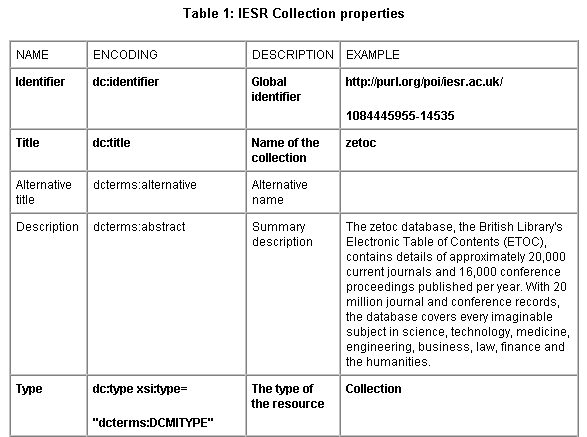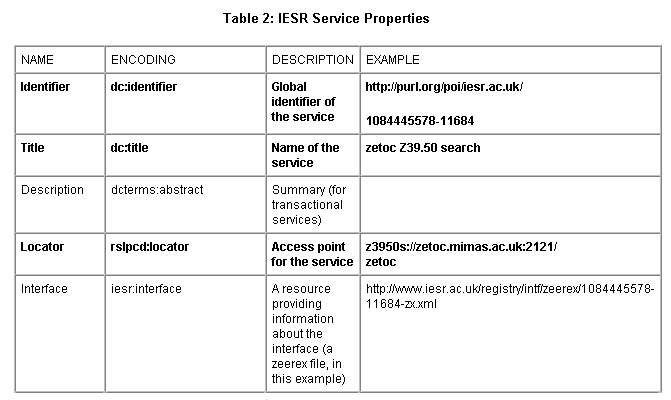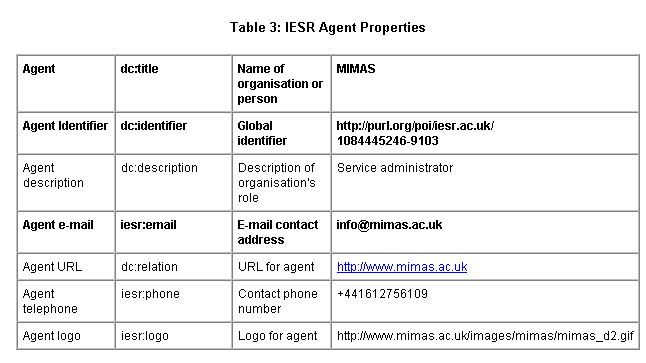The Information Environment Service Registry: Promoting the Use of Electronic Resources
The last ten years have seen a huge investment in the creation of electronic resources for use by researchers, students and teachers. Increasing amounts of money are being spent now on providing portals and virtual learning environments (or learning management systems) for use within institutions and organisations, or for people focusing on particular subject areas. A portal is defined by the Joint Information Systems Committee (JISC) as -
" - a network service that brings together content from diverse distributed resources using technologies such as cross searching, harvesting, and alerting, and collates this into an amalgamated form for presentation to the user." [1]
It follows from this definition that portal developers need to have knowledge of the electronic resources (or collections) that are available for their users. In order to provide cross-searching, harvesting and alerting functions, the portals also need to have information about the electronic entry points to those resources.
The Information Environment Service Registry (IESR) has been developed (with funding from the JISC) to provide a central source of information about many of these electronic resources and the ways in which they can be accessed. The important difference between the IESR and other online directories is that the IESR is primarily being designed to be accessed by other applications; as a machine-to-machine service, rather than simply as a Web interface for human users.
The aim is that portals and other services will be able to use the registry as a source of information about which collections are available, and also as a means of providing direct access to those collections; either to their Web pages or through any machine-to-machine services that may be supported by the resources (for example, a Z39.50 search interface or a metadata harvesting protocol).
Designing the Service Registry
Work on creating the IESR began in November 2002 and the project is now in its second phase (due to end in February 2005). Much time was spent in the first phase of the project in determining the structure of the XML metadata which would be needed for the registry.
The IESR describes three different entities: collections, services (which provide access to the collections) and agents (organisations which own the collections and/or administer the services). These entities are represented in the diagram below:

Figure 1: IESR Entities and their Relationships
The IESR is also able to describe transactional services, i.e. those which do not have an associated collection. One example of such a service would be an institution's OpenURL resolver, which passes information, such as bibliographic details about a journal article, from one application to another in order to locate a copy of the item through a local subscription. In the IESR a transactional service is linked only to the agent which administers the service.
The metadata used to describe these entities was developed during 2003. The project team includes staff from UKOLN, the Cheshire development team at the University of Liverpool, and MIMAS, who between them had accumulated a good range of experience in the fields of metadata design, collection description and providing access to electronic resources. This combination of experience has proved invaluable for the project. Input from the project's stakeholder community was also very important, as explained in Verity Brack and Amanda Closier's article in issue 36 of Ariadne [2].
The IESR metadata for each of its entities is described in the following section. Further detail, including the IESR Application Profile and additional examples, is available in the Metadata section of the IESR Web site [3].
Collection Descriptions
The IESR collection information is based on the RSLP (Research Support Libraries Programme) collection description schema and describes the electronic resource. The mandatory fields are shown as bold in the table below. Administrative metadata relating to the creation of the IESR entry is not shown. The example given shows extracts from the collection description for zetoc. All entities within the IESR are allocated a unique reference, using a PURL-based Object Identifier [4].

Screenshot of Extract from Table 1: IESR Collection properties
There are three fields in the collection description relating to rights: Rights, Use Rights and Access Rights. Rights (dc:rights) is a statement about the ownership of copyright in the collection. Use Rights (iesr:useRights) defines the allowed use of data from the collection, while Access Rights determines who can actually get to the collection in the first place. The IESR metadata itself is made available under a Creative Commons licence [5]. This is set in one of the administrative metadata fields with a fixed value of:
<dc:rights xsi:type="dcterms:URI">http://creativecommons.org/licenses/by-nc-sa/1.0/</dc:rights>
This means that all the metadata within the Service Registry can be copied and distributed for non-commercial purposes, but that attribution must be given to the original author.
Service Descriptions
Each IESR collection description is associated with at least one service description, which holds information about a method of accessing the collection. The RSLP Locator property is used to identify the access point as a URL. This is sufficient information for access to some types of service: an OAI-PMH (Open Archives Initiative Protocol for Metadata Harvesting) repository for example, but more information is required for other methods of access. So in the description for a Web Service, the 'Interface' property is used to point to the WSDL (Web Services Description Language) file, which contains information on how other applications can interact with the service. The table below shows the metadata associated with a service description, again using zetoc as an example and excluding the administrative information about the creation of the description. In this case it is the Z39.50 interface to zetoc that is being described.

Screenshot of Extract from Table 2: IESR Service Properties
Agents
Agents are the owners of collections and the administrators of the services which provide access to the collections. The mandatory information recorded about agents includes their name and e-mail address. In the future these contact details may be used to alert administrators in the event that their services are unavailable for a significant period of time, or to trigger a reminder to check the currency of the IESR's information about a service or collection.

Screenshot of Extract from Table 3: IESR Agent Properties
Using the Information in the IESR
In conducting research among the stakeholder community, there was an encouraging response to the question 'Would you make use of the IESR?', with 83% of stakeholders indicating that they would. A major challenge for the project team now is to convert that theoretical willingness into real use of the registry. One important factor in this process is the provision of as many routes as possible to the data within the registry.
The IESR is currently (June 2004) available through Web and Z39.50 interfaces. The Web interface is most likely to be used by contributors to the IESR as a means of checking their descriptions [6]. Z39.50 access allows other services and applications to access the IESR metadata in various formats: these are described on the Z39.50 access page of the IESR Web site [7]. Key tasks for the current phase of the project are to extend the methods of access to the registry by making the data available through OAI-PMH and via a SRW (Search and Retrieve Web Service) interface.
It is thought that the principal users of the Service Registry's information will initially be the portals described above, using the service as a means of obtaining information about resources and the ways in which they can be accessed. For resources that support machine-to-machine interaction, portals will be able to provide cross-searching facilities using the information within the IESR. By providing access to a central registry, there should be less work involved for the developers of portals in keeping information about these key resources up to date.
Content of the IESR
The records in the registry were supplied in the first phase of the project by six JISC service providers: AHDS, EDINA, MIMAS, RDN, UK Data Archive, UK Mirror Service. In all, 250 collection descriptions were submitted with their associated service descriptions and metadata about agents. To create the descriptions, the data providers had the option of completing XML templates or Excel spreadsheets. The spreadsheet data was converted into XML at MIMAS and then loaded into the Service Registry. One of the priorities for the current phase of the project is to make the submission and alteration of data more straightforward for all involved, by providing a Web form for entering and editing IESR metadata.
Quality control is an important part of the data submission process. A certain amount of data checking is built into the process of loading data into the Service Registry: ensuring that mandatory fields have been completed, for example. The project team's Content Manager also performs a manual check on the data, to ensure that it is as consistent as possible. Particular attention is paid to potentially problematic areas such as subject headings. His liaison with data contributors is extremely important, as experience in other projects has shown that a collaborative approach to compiling metadata is the best way to produce accurate and complete information about resources. A recent paper by Jane Barton, Sarah Currier and Jessie Hey provides a useful analysis of this area of work [8].
The IESR aims to be a catalogue of the high-quality resources available within the JISC's Information Environment, and beyond. 'Beyond' in this context may include the resources owned and administered by other public bodies, such as those represented on the Common Information Environment Group [9]. Membership of the group includes representatives from Becta, the British Library, the e-Science Core Programme, the JISC, MLA (the Council for Museums, Libraries and Archives), the National Archives, the National Health Service and the UK Government. The CIE initiative is aiming to encourage collaboration in the provision of digital content by a range of UK organisations. More information about it can be found in Paul Miller's Ariadne article of April 2004 [10]. The IESR could hold information about the services provided by the organisations represented in the CIE group.
Although the IESR has a machine-to-machine focus, the majority of the resources currently described within it are accessible only through Web pages. The access methods described by the service descriptions within the service in June 2004 break down in the following manner:
| Web pages | 91% |
| Z39.50 | 6% |
| Web cgi | 1% |
| OAI | <1% |
| OpenURL | <1% |
| RSS | <1% |
Table 4: Proportion of Different Service Types Described in the IESR, June 2004
The expectation is that these proportions will change as the technology of Web services becomes more widely adopted and increasing numbers of resources are made available through machine-to-machine methods. Tracy Gardner gave an introduction to Web services in an Ariadne article [11], while Andy Powell's 'Five step guide to becoming a content provider in the JISC Information Environment' gives a good overview of the other ways in which administrators can make the content of their collections more accessible to other services [12].
Conclusion
In some ways the IESR is a service that is being designed for the way that things will be in the near future, rather than the way that things are right now. Machine-to-machine interfaces have been relatively rare outside of the world of library OPACs, but this is beginning to change, particularly with the push towards providing institutional repositories of learning materials and e-prints.
The IESR should make it possible for other services to provide some reliable answers to the questions like 'What is the best place to look for learning objects about landscape gardening?' or 'Which resources provide RSS feeds related to physical geography?'. It may also encourage more service providers to look at alternative ways of presenting their content, to ensure the widest possible availability and use of their resources.
Acknowledgements
The author would like to acknowledge that it would not have been possible to write this article without building on the work of other members of the IESR team, particularly that of Ann Apps, Pete Johnston and Leigh Morris.
References
- JISC Portals FAQ at http://www.jisc.ac.uk/index.cfm?name=ie_portalsfaq
- Brack, V. and Closier, A., "Developing the JISC Information Environment Service Registry", Ariadne 36, July 2003, http://www.ariadne.ac.uk/issue36/jisciesr/
- IESR Metadata: http://www.iesr.ac.uk/metadata/
- Powell, A., Young, J. and Hickey, T., "The PURL-based Object Identifier (POI)", 2003, http://www.ukoln.ac.uk/distributed-systems/poi/
- Creative Commons: http://creativecommons.org/
- The Web interface to the service registry is at http://www.iesr.ac.uk/registry/
- Details of Z39.50 access to the IESR are at: http://iesr.ac.uk/registry/docs/iesrZ3950.html
- Barton, J; Currier, S & Hey, J (2003) Building Quality Assurance into Metadata Creation: an Analysis based on the Learning Objects and e-Prints Communities of Practice, DC-2003, http://www.siderean.com/dc2003/201_paper60.pdf
- The CIE pages can be found at: http://www.jisc.ac.uk/index.cfm?name=wg_cie_home
- Miller, P., "Towards the Digital Aquifer: introducing the Common Information Environment", Ariadne 39, April 2004, http://www.ariadne.ac.uk/issue39/miller/
- Gardner, T., "An Introduction to Web Services", Ariadne 29, October 2001 http://www.ariadne.ac.uk/issue29/gardner/
- Powell, A., "5 step guide to becoming a content provider in the JISC Information Environment", Ariadne 33, September-October 2002, http://www.ariadne.ac.uk/issue33/info-environment/
